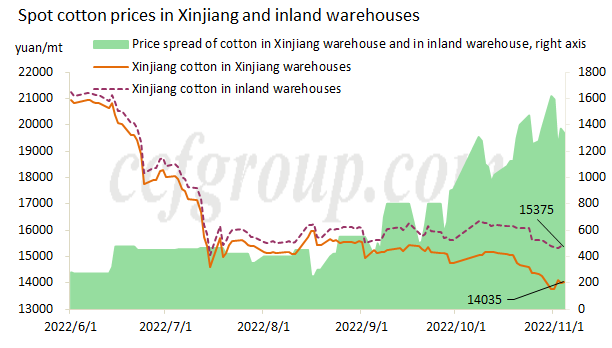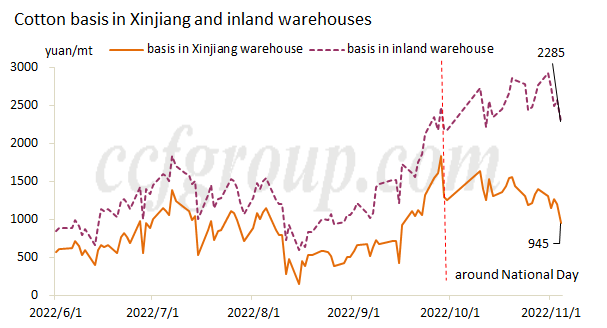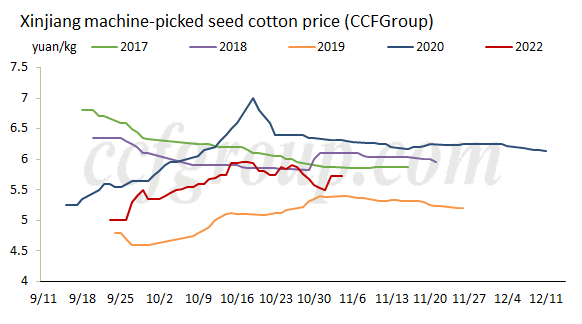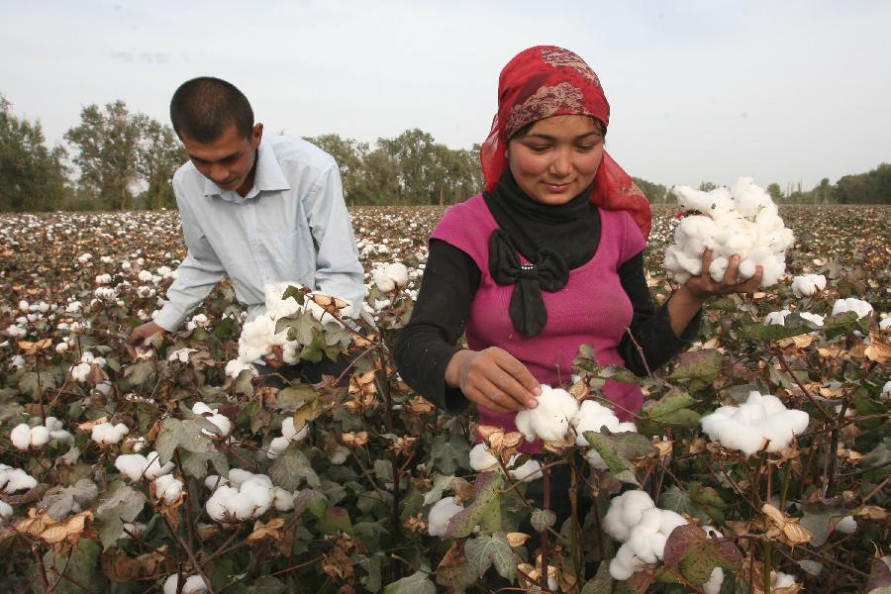Current China spot cotton market is in disorder overall, with new and old cotton, above 1,000yuan/mt price spread between Xinjiang cotton in Xinjiang warehouse and inland warehouse and spot sales and pre-sales of new cotton. The epidemic impacts cotton transportation from Xinjiang to inland, and traders are worrying about the risks of transportation. Textile mills in inland not only face the lack of orders, but also lack of the feedstock. The notary-inspection speed of Xinjiang cotton is slow obviously, arousing the attention of delivery of warehouse receipts later. The epidemic this year makes cotton market more difficult, while it weakens the pressure of intensive arrivals of new cotton as well, and some ginners sell fast. Sales and ginners of ginners are better than last year. Moreover, there is rumor about the changes on epidemic-related measures in China in early Nov, stimulating the market fast. The basic situation of current spot cotton market is showed below.
1. Cotton prices are mixed and spinners have different feedstock costs
The spot cotton market is in disorder in Oct. As the transportation of cotton from Xinjiang to inland is affected by the epidemic, there were big differences between cotton in Xinjiang warehouses and in inland warehouse, with a price spread of above 1,000yuan/mt. By Nov 4, the comprehensive trading prices of cotton in Xinjiang warehouses were 14,035yuan/mt, and that in inland warehouse were 15,375yuan/mt, with a price spread of 1,340yuan/mt. Due to slow notary-inspection speed of new cotton, some cotton is sold without indicators or pre-sold. Overall, cotton prices are mixed. In fact, the purchase prices of Xinjiang cotton for textile mills are about 13,500-16,000yuan/mt, delivered in inland warehouse, with quite big differences.

2. Spot cotton basis in Xinjiang and inland warehouses also expands
From the perspective of cotton basis (Chinese cotton price-ZCE cotton futures spread), though cotton is hard to be transported after Oct impacted by the epidemic, the basis has increased significantly compared with the level before National Day holiday, but the basis in Xinjiang warehouse is weakening gradually, and that in inland warehouse has moved up.
The notary-inspection speed of new cotton is slow. Currently, ginning volumes of new cotton are about 1 million tons, while the notary-inspection volumes are less than 0.3 million tons (the data just for reference), so the cotton inventory at ginners’ hands is not large, but ginners show strong selling interests, so cotton basis in Xinjiang warehouse is weakening gradually. Moreover, ginners are also active to pre-sell and find hedging opportunity. On Nov 1, there were rumors that China might relax the epidemic-related control measures in Mar, 2023 and stimulated by this, stock and commodity markets increased. Moreover, US Fed settled to raise the interest rate by 75bps in Nov, US dollar index fell down and ICE cotton futures hit the up limit for two days, still up by 4cent/lb on Nov 4. Under such condition, ZCE major cotton contract also rose to 13,500yuan/mt. After ZCE Jan contract rose above 13,000yuan/mt, part of ginners were active to do hedging, and some traders were active to purchase.

3. Ginners are active to sell cotton with good profits
As the circulation of seed cotton is unsmooth affected by the epidemic, ginners in Xinjiang have different costs in 2022/23 season. In some regions, the costs are below 12,000yuan/mt, while in Kashgar and Kuitun, costs are above 13,000yuan/mt or even reach 14,000yuan/mt. Nevertheless, according to our survey, the costs of most ginners in Xinjiang are below 13,000yuan/mt. From Sep 27 to Nov 4, the seed cotton prices are averaged at 5.65-5.7yuan/kg in Xinjiang, and costs are about 12,600yuan/mt. Therefore, when ZCE Jan contract rises to 13,000yuan/mt and above, ginners are more willing to do hedging. Meanwhile, ginners have relatively good profits.

Viewed from the fundamental, the notary-inspection volumes of new cotton are still limited, and most of inspected cotton has been sold, while the open interests of ZCE Jan contract have reached 2.64 million tons. Moreover, the epidemic has not eased apparently in Xinjiang. The possible short squeeze is likely to be the positive factor. However, hedging pressure will continue to increase if ZCE cotton futures keep up. Meanwhile, the epidemic not only influences the supply side, but also the demand side. The downstream plant operating rate in Guangzhou and Shandong is affected recently, and in some regions, cotton inventory in spinning mills is low, and cotton yarn sales are bleak, resulting into lower operating rate. The pressure is just delayed but not disappeared. Cotton prices have no long-term upward momentum from the fundamental. In addition, the fluctuations of commodity market are influenced by the macro environment and capital mood. The commodity market is supported by the rumors about the changes on epidemic-related measures on Nov 1 and Nov 4, but on Nov 5, on the press conference of joint prevention and control mechanism of the State Council, Health Commission states to persist the dynamic zero-COVID policy. If capital is shifted quickly, commodity market faces further downward risks. Watch the overall market closely.
Πηγή: ccfgroup.com/

